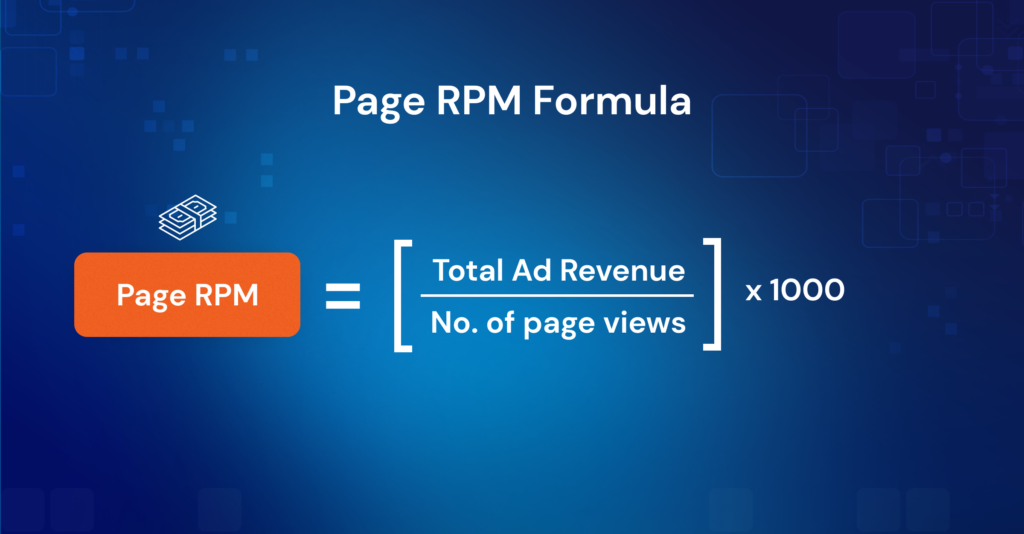CPM and RPM are two metrics that help publishers track their revenue. Despite their differences, new publishers often confuse these metrics.
Advertisers use CPM to determine the cost of running an ad campaign. Though it is a metric primarily defined by the advertiser’s expenses, publishers can also use CPM to estimate their revenue.
RPM, conversely, is a metric mainly used by publishers to monitor the performance and earnings of an ad campaign.
Understanding the Significance of CPM for Publishers
By understanding the CPM rates of their platforms, publishers can set appropriate pricing for their ad space and optimize their ad revenue. Tracking CPM offers several benefits for publishers, including:
- Maximizing revenue: By monitoring CPM, publishers can accurately price their ad inventory and ensure they earn the maximum revenue for each impression generated on their platform.
- Identifying high-value advertisers: Publishers can use CPM data to identify advertisers willing to pay premium prices for their ad space.
- Optimizing ad formats: CPM data can help publishers pinpoint ad formats that perform well and generate higher revenue.
- Making data-driven decisions: Tracking CPM provides publishers with valuable data, enabling them to make informed decisions about their ad strategy, pricing, and overall revenue maximization. By analyzing CPM, publishers can monitor and optimize ad campaign metrics effectively.
The Importance of RPM for Publishers

RPM helps publishers calculate estimated earnings and make informed decisions based on accurate data. Some benefits of tracking RPM for publishers include:
- Revenue optimization: RPM enables publishers to accurately monitor ad revenue, helping them identify which ad formats and placements perform best. This allows publishers to optimize their ad strategy and maximize revenue.
- Comparison across platforms: Publishers can use RPM to compare their ad inventory’s performance across different platforms and ad networks, identifying which networks provide the best returns.
- Efficient pricing: By analyzing RPM data, publishers can understand the value of their ad inventory and set pricing for advertisers accordingly. This can lead to more profitable partnerships and higher-quality ads.
- Insights into ad performance: RPM data offers valuable insights into ad campaign performance beyond just revenue measurement. By analyzing RPM alongside other metrics, such as click-through rates and conversions, publishers can evaluate the success of their ad campaigns and develop effective ad strategies for the future.
CPM vs RPM: What’s the Distinction?
Here are some of the other differences between CPM and RPM:
- Target: While CPM is an advertiser-centric metric, RPM is a publisher-centric metric.
- Tracking: CPM is useful for tracking the cost of an ad campaign, whereas RPM tracks the revenue earned from ads.
- Ad Placement: CPM is often used to determine the price of ads based on their placement, while RPM focuses on the overall revenue generated by ads across a website or app.
- Bidding: CPM is used in ad auctions provided by ad networks, such as Google AdSense, to determine the cost per impression of an ad, whereas RPM is not used for bidding.
- Ad Units: CPM measures the cost per impression of individual ads, while RPM measures the revenue earned from all ads.
- Pageviews: CPM is based on impressions across a website or app, regardless of its type, while RPM also considers pageviews when measuring page RPM for websites.
RPM vs CPM: Which Is the Best Choice for Publishers?
While both CPM and RPM are important metrics for publishers, they serve different purposes.
RPM represents the revenue generated for every 1,000 impressions of ads on a publisher’s platform and is therefore comparatively more important for publishers. It provides a more accurate view of how much revenue publishers are generating from their ads, allowing them to optimize ad placements and formats.
Additionally, since RPM takes into account page views, publishers can increase page RPM by optimizing page-related metrics such as website speed and content quality.
That being said, keeping an eye on CPM is also important for publishers. CPM is an indicator of ad quality and can directly impact the user experience on a website or app. A low CPM may indicate that the ads are not relevant or engaging, which may result in fewer clicks.
Another important aspect to note is that RPM doesn’t tell the whole story. It is based on all of the page’s ad units, regardless of whether or not they received impressions.
Therefore, it is essential to consider both RPM and CPM to ensure good ad revenue while maintaining a positive user experience.
By collaborating with ProPS, publishers can optimize both CPM and RPM, ensuring efficient ad management and maximizing revenue across their digital platforms.
